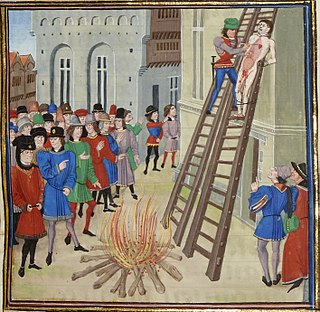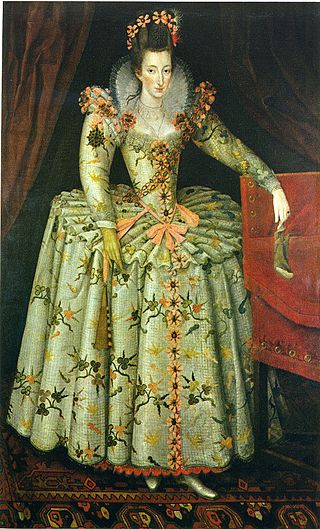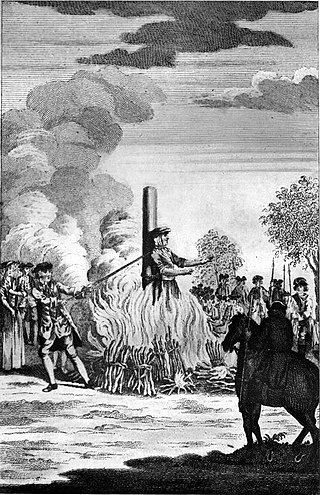
Margaret Plantagenet, Countess of Salisbury, was the only surviving daughter of George Plantagenet, Duke of Clarence and his wife Isabel Neville. As a result of Margaret's marriage to Richard Pole, she was also known as Margaret Pole. She was one of just two women in 16th-century England to be a peeress in her own right without a husband in the House of Lords.

Newgate Prison was a prison at the corner of Newgate Street and Old Bailey, just inside the City of London, England, originally at the site of Newgate, a gate in the Roman London Wall. Built in the 12th century and demolished in 1904, the prison was extended and rebuilt many times, and remained in use for over 700 years, from 1188 to 1902.

Lady Christian Henrietta Caroline Acland was a British noblewoman and diarist. She accompanied her husband to British North America and became celebrated for her personal courage. She is commemorated on one of the bronze reliefs on second floor of the Saratoga Monument in the State of New York.

The Knavesmire is one of a number of large, marshy undeveloped areas within the city of York in North Yorkshire, England, which are collectively known as Strays. Knavesmire, together with Hob Moor, comprises Micklegate Stray. The York Tyburn, the site of a gallows administered on behalf of The Crown by York Castle, was situated in the area adajcent to the Tadcaster Road.

Jane Neville, Countess of Westmorland, was an English noblewoman who had a role in the Northern Rebellion in 1569 against Elizabeth I of England.
Events from the year 1685 in England. This year sees a change of monarch.

To be hanged, drawn and quartered was a method of torturous capital punishment used principally to execute men convicted of high treason in medieval and early modern Britain and Ireland. The convicted traitor was fastened to a hurdle, or wooden panel, and drawn behind a horse to the place of execution, where he was then hanged, emasculated, disembowelled, beheaded, and quartered. His remains would then often be displayed in prominent places across the country, such as London Bridge, to serve as a warning of the fate of traitors. The punishment was only ever applied to men; for reasons of public decency, women convicted of high treason were instead burned at the stake.
William Monson, 1st Viscount Monson was one of the Regicides of King Charles I of England.

Anne Vavasour was a maid of honour (1580–81) to Queen Elizabeth I of England, a member of the Vavasour family and the mistress of two aristocratic men. Her first lover was Edward de Vere, 17th Earl of Oxford, by whom she had an illegitimate son – Edward. For that offence, both she and de Vere were sent to the Tower of London by the orders of the Queen. She later became the mistress of Sir Henry Lee of Ditchley, by whom she had another illegitimate son.
Agnes, Lady Hungerford was a murderer and the second wife of Sir Edward Hungerford. When he died in 1522, Agnes was then charged and convicted of the murder of her first husband, John Cotell. She was hanged at Tyburn in 1523.

Walter Calverley was an English squire from Yorkshire.

Catherine Hayes, sometimes spelled Catharine Hayes, was an English woman who was burned at the stake for committing petty treason by killing her husband.
Sir Francis Bigod was an English nobleman who was the leader of Bigod's Rebellion.
George Markham served as Dean of York from 1802 and Rector of Stokesley until his death.

Richard Neville, 2nd Baron Latimer of Snape, North Yorkshire, was an English soldier and peer. He fought at the battles of Stoke and Flodden.

In England, death by burning was a legal punishment inflicted on women found guilty of high treason, petty treason, and heresy during the Middle Ages and Early Modern period. Over a period of several centuries, female convicts were publicly burnt at the stake, sometimes alive, for a range of activities including coining and mariticide.
Elizabeth Ridgeway was an English woman convicted of poisoning her husband. While awaiting execution by burning at the stake, she confessed to previously poisoning her mother, a fellow servant, and a lover.
Mary Hobry was a 17th-century midwife living in England, convicted for murdering her abusive husband and burnt at the stake.
Mary Channing was an English woman from the county of Dorset. Channing is known for being convicted of poisoning her husband and being burnt at the stake.
Alma Victoria Rattenbury was an English-Canadian songwriter and accused murderer.










